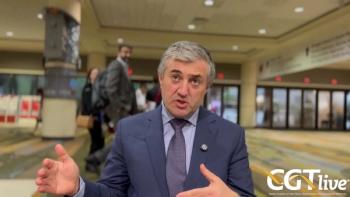
Overcoming AAV Barriers and Limitations to Treat Duchenne Muscular Dystrophy
Melissa Spencer, PhD, spoke about the emerging role of adeno-associated virus as a delivery system for gene therapies targeting muscular dystrophies, and the challenbges associated with them.
At the recent American Association of Neuromuscular & Electrodiagnostic Medicine annual meeting in Savannah, Georgia, CGTLive®'s sister site, NeurologyLive®, spoke with Melissa Spencer, PhD, a professor in residence at UCLA Health and an expert in neuromuscular gene therapy who has primarily spent her time trying to understand the pathogenic mechanisms that occur in muscular dystrophies to develop therapeutic interventions. Much of her and her lab’s work has been focused on questions pertaining to the immune system’s contribution to Duchenne muscular dystrophy (DMD), specifically.
In the conversation, Spencer delved into the complexities of adeno-associated virus (AAV) as a gene delivery vehicle, highlighting its current role as the primary means to introduce therapeutic nucleic acids into muscle tissue. However, although AAV has shown efficacy, it presents some challenges related to the broad tissue distribution and potential adverse effects of therapy delivery, including liver toxicity and complement activation.
Spencer offered her perspective on the nuanced decision-making required for treating DMD, and the dilemma of balancing early intervention with the difficulty of assessing functional improvement over time. She also emphasized the need for innovation in gene therapy vectors, particularly those with increased specificity for skeletal muscle and stem cells, which could lead to more durable, targeted treatments.
Can you describe your talk in detail and why this was a topic of conversation for you?
Melissa Spencer, PhD: My talk focused on adeno-associated virus, or AAV, which is the delivery vehicle used to transport nucleic acids into the body for gene therapies. This can be for gene replacement or gene editing. You can package any nucleic acid into AAV, and muscle is a particularly difficult target because there's so much of it and it's distributed throughout the body. AAV is really the only efficient way to deliver genes to muscle for muscle-based diseases, although there have been some recent reports of intrathecal administration reaching the muscle, which is exciting. That could mean using lower doses, less AAV, and potentially avoiding some of the adverse events like liver toxicity and complement activation.
I also discussed the difficulty of assessing function or functional benefits in Duchenne muscular dystrophy, which is a degenerative disease. There's this paradox where you want to treat very early while they still have a lot of muscle, but the disease is already causing muscle loss, yet the patients are still growing and gaining strength up until around age seven. Most trials start from age seven because that's when you can clearly see functional decline, but by then, they don’t have as much muscle to treat. So, it’s a real challenge—how do you assess function after gene therapy and treat early without losing durability too soon?
Do you feel the community is aware of the limitations of AAV delivery?
Well, we can only address these problems one at a time, so I’m not sure how aware the broader community is. Certainly, we’re dealing with the best outcome measures we can right now. We also have challenges in standardizing processes across different companies, like AAV production and how to assess pre-existing immunity. Whether the community is fully aware or not, I can't say. Ultimately, we want to develop treatments and get them to patients as soon as possible. We can test things in mice, but the real test is in patients. So, we learn with each trial. I don’t want to put a negative spin on it—we work with the best tools we have and apply them as safely as possible to avoid harm, and then we learn and move forward.
Are there specific gene therapy vehicles you believe hold more promise?
I think we need better vectors that are more myotropic, meaning they have higher tropism for skeletal muscle. There are a few promising ones, like MyoAAV and AAVMyo—they’re very similar in name. These work well at lower doses and are less likely to target the liver. Some are specifically de-targeted from the liver, which is important because the liver is a major sink for AAV. The liver just absorbs AAV, so if you can de-target it, more is available for muscle. These vectors show a lot of promise, and I hope more people start using them. We are considering them for our gene therapy trials for limb girdle muscular dystrophy type 2A, and the collaboration is going well.
Where we need improvement is in AAVs that target specific cell types, like muscle stem cells for CRISPR therapies. If you can target and edit muscle stem cells, you could make a permanent change. These stem cells regenerate muscle, so editing them could lead to a long-lasting therapy. Right now, there aren’t any AAV vectors that specifically target microglia, but that would be helpful for certain applications. We're also screening for AAVs that target microglia and other cell types.
Have there been issues identifying the right patients for gene therapy trials?
We definitely need more standardized assays to determine who has pre-existing immunity, and we need more than just screening for neutralizing and binding antibodies. We should be looking at memory responses because, if someone was exposed to wild-type AAV long ago, they might not have circulating antibodies now, but their immune system could still react. We also need to understand how polymorphisms affect the complement system—some people may have a predisposition for quick activation. There’s also some emerging data suggesting that coincident viral infections, like human herpesvirus, might tip the balance and cause things like thrombotic microangiopathy (TMA). We still need to study this more, but it shows how much we don’t fully understand yet. We need better communication and collaboration across the community, sharing samples and data so we don’t expose patients to unnecessary risks.
In terms of research, where should future efforts be focused?
We need better micro-dystrophins and also larger dystrophins, like the split-inteins Jeff Chamberlain developed. Better AAV vectors are critical, not just for muscle but for stem cells as well. Understanding the immune response is also crucial. It’s challenging to study this in mice in a way that translates well to humans. We’re constantly trying to validate what we see in mice with human data, and as we gather more samples, we’ll get a better understanding. One key finding is that if you give two doses of AAV to mice—not just one—you start to see some of the effects that occur in patients. Mice in labs live in sterile environments and are never exposed to AAV, whereas humans are exposed to varying degrees of AAV throughout their lives, even if it’s not detectable in current assays. If we could develop a mouse model that reflects the human immune response to AAV more accurately, it would be a very valuable tool.
Transcript edited for clarity.
Newsletter
Stay at the forefront of cutting-edge science with CGT—your direct line to expert insights, breakthrough data, and real-time coverage of the latest advancements in cell and gene therapy.




































